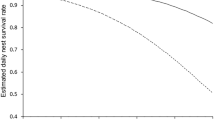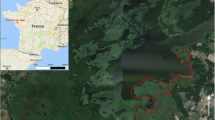Abstract
This paper presents modern methods for assessing the nest survival, which are implemented in the free software MARK. Using the example of the data of long-term monitoring of the breeding success of two passerine bird species, the capabilities of the method in assessing the intra- and interannual variability of the daily nest survival rate as well as the dependence of the latter on weather conditions are demonstrated. The analysis is based on a sample of 523 booted warbler (Iduna caligata) nests and 553 whinchat (Saxicola rubetra) nests monitored on abandoned fields of Vologda oblast in 2005–2018. The daily nest survival rates failed to differ between the two species and showed significant interannual variations. Intraseasonal variations in the daily survival rates were weaker than interannual ones. The daily nest survival rate depended nonlinearly on nest age, this effect showing different directions in different years. In some years, the mean daily air temperature rendered a significant impact on the nest daily survival rate.


Similar content being viewed by others
REFERENCES
Antonov, A.I., Nesting ecology of the eastern curlew, Numenius madagascariensis (Linnaeus, 1766) in the south of the species range, Russ. J. Ecol., 2010, vol. 41, no. 4, pp. 345–346.
Arnold, T.W., Uninformative parameters and model selection using Akaike’s information criterion, J. Wildlife Manage., 2010, vol. 74, pp. 1175–1178.
Bart, J. and Robson, D.S., Estimating survivorship when the subjects are visited periodically, Ecology, 1982, vol. 63, no. 4, pp. 1078–1090.
Border, J.A., Henderson, I.G., and Hartley, I.R., Characterising demographic contributions to observed population change in a declining migrant bird, J. Avian Biol., 2017, vol. 48, pp. 1139–1149.
Burnham, K.P. and Anderson, D.R., Model selection and inference: a practical information theoretic approach, New York: USA Springer, 2002.
Chernyshov, V.M., The ecological features of the booted warbler (Hippolais caligata) in the Baraba forest–steppe, Contemp. Probl. Ecol., 2013, vol. 6, no. 1, pp. 77–84.
Cox, W.A., Thompson, F.R., and Reidy, J.L., The effects of temperature on nest predation by mammals, birds, and snakes, Auk, 2013, vol. 130, no. 4, pp. 784–790.
DeGregorio, B.A., Weatherhead, P.J., and Sperry, J.H., Power lines, roads, and avian nest survival: effects on predator identity and predation intensity, Ecol. Evol., 2014, vol. 4, no. 9, pp. 1589–1600.
Demidova, E.Yu., Life cycles of thrushes (genera Turdus, Zoothera) of the Yenisei middle taiga, Extended Abstract of Cand. Sci. (Biol.) Dissertation, Moscow, 2012.
Dinsmore, S.J. and Dinsmore, J.J., Modeling avian nest survival in program MARK, Stud. Avian Biol., 2002, no. 34, p. 11.
Dinsmore, S.J., White, G.C., and Knopf, F.L., Advanced techniques for modeling avian nest survival, Ecology, 2002, vol. 83, no. 12, pp. 3476–3488.
Evans, K.L., The potential for interactions between predation and habitat change to cause population declines of farmland birds, Ibis, 2004, vol. 146, no. 1, pp. 1–13.
Fischer, K., Busch, R., Fahl, G., Kunz, M., and Knopf, M., Habitat preferences and breeding success of whinchats (Saxicola rubetra) in the Westerwald mountain range, J. Ornithol., 2013, vol. 154, pp. 339–349.
Frankiewicz, J., Breeding biology and ecology of whinchat Saxicola rubetra on abandoned farmland of Opole Province (SW Poland), Acta Zool. Cracov., Ser. A: Vertebr., 2008, vol. 51, pp. 35–47.
Grant, T.A. and Shaffer, T.L., Time-specific patterns of nest survival for ducks and passerines breeding in North Dakota, Auk, 2012, vol. 129, no. 2, pp. 319–328.
Grant, T.A., Shaffer, T.L., Madden, E.M., Pietz, P.J., and Johnson, D.H., Time-specific variation in passerine nest survival: new insights into old questions, Auk, 2005, vol. 122, no. 2, pp. 661–672.
Grant, T.A., Shaffer, T.L., Madden, E.M., and Nenneman, M.P., Contrasting nest survival patterns for ducks and songbirds in northern mixed-grass prairie, J. Wildlife Manage., 2017, vol. 81, no. 4, pp. 641–651.
Grüebler, M.U., Schuler, H., Horch, P., and Spaar, R., The effectiveness of conservation measures to enhance nest survival in a meadow bird suffering from anthropogenic nest loss, Biol. Conserv., 2012, vol. 146, pp. 197–203.
Gullett, P.R., Hatchwell, B.J., Robinson, R.A., and Evans, K.L., Breeding season weather determines long-tailed tit reproductive success through impacts on recruitment, J. Avian Biol., 2015, vol. 46, no. 5, pp. 441–451.
Ibáñez-Álamo, J.D., Magrath, R.D., Oteyza, J.C., Chalfoun, A.D., Haff, T.M., Schmidt, K.A., Thomson, R.L., and Martin, T.E., Nest predation research: recent findings and future perspectives, J. Ornithol., 2015, vol. 156, pp. 247–262.
Johnson, D.H., Estimating nest success: a guide to the methods, Stud. Avian Biol., 2007, no. 34, pp. 65–72.
Kochanov, S.K. and Danilova, E.V., Ecology of a rook (Corvus frugilegus Linnaeus, 1758) on the northern border of its distribution (European northeast of Russia), Vestn. Inst. Biol. Komi Nauchn. Tsentra Ural. Otd. Ross. Akad. Nauk, 2016, no. 2 (196), pp. 12–17.
Korosov, A.V., Ekologiya obyknovennoi gadyuki na severe (Ecology of the Common Viper in the North), Petrozavodsk: Petrozavodsk. Gos. Univ., 2010.
Kubelka, V., Salek, M., Tomkovich, P., Vegvari, Z., Freckleton, R.P., and Szekely, T., Global pattern of nest predation is disrupted by climate change in shorebirds, Science, 2018, vol. 362, pp. 680–683.
Kus, B.E., Peterson, B.L., and Deutschman, D.H., A multiscale analysis of nest predation on least bell’s vireos (Vireo bellii pusillus), Auk, 2008, vol. 125, no. 2, pp. 277–284.
Lloyd, J.D. and Tewksbury, J.J., Analyzing avian nest survival in forests and grasslands: a comparison of the mayfield and logistic-exposure methods, Stud. Avian Biol., 2007, vol. 34, pp. 96–104.
Loman, Z.G., Monroe, A.P., Riffell, S.K., Miller, D.A., Vilella, F.J., Wheat, B.R., Rush, S.A., and Martin, J.A., Nest survival modeling using a multi-species approach in forests managed for timber and biofuel feedstock, J. Appl. Ecol., 2018, vol. 55, no. 2, pp. 937–946.
Ludlow, S.M., Brigham, R.M., and Davis, S.K., Nesting ecology of grassland songbirds: effects of predation, parasitism, and weather, Wilson J. Ornithol., 2014, vol. 126, pp. 686–699.
Martin, T.E., Avian life history evolution in relation to nest sites, nest predation, and food, Ecol. Monogr., 1995, vol. 65, pp. C.101–127.
Martin, T.E., Scott, J., and Menges, C., Nest predation increases with parental activity: separating nest site and parental activity effects, Proc. R. Soc. London, Ser. B, 1995, vol. 65, pp. 2287–2293.
Mayfield, H.F., Nesting success calculated from exposure, Wilson Bull., 1961, vol. 73, no. 3, pp. 255–261.
Mayfield, H.F., Suggestions for calculating nest success, Wilson Bull., 1975, vol. 87, no. 4, pp. 456–466.
Newmark, W.D. and Stanley, T.R., Habitat fragmentation reduces nest survival in an afrotropical bird community in a biodiversity hotspot, Proc. Natl. Acad. Sci. U. S. A., 2011, vol. 108, pp. 11488–11493.
Paevskii, V.A., Demografiya ptits (Demography of Birds), Leningrad: Nauka, 1985.
Paevskii, V.A., Demograficheskaya struktura i populyatsionnaya dinamika pevchikh ptits (Demographic Structure and Population Dynamics of Songbirds), St. Petersburg: KMK, 2008.
Powell, L.A., Approximating variance of demographic parameters using the delta method: a reference for avian biologists, Condor, 2007, vol. 109, no. 4, pp. 949–954.
Remeš, V., Nest concealment and parental behaviour interact in affecting nest survival in the blackcap (Sylvia atricapilla): an experimental evaluation of the parental compensation hypothesis, Behav. Ecol. Sociobiol., 2005, vol. 58, no. 3, pp. 326–332.
Roach, M.C., Thompson, F.R., and Jones-Farrand, T., Songbird nest success is positively related to restoration of pine-oak savanna and woodland in the Ozark Highlands, Missouri, USA, Condor, 2018, vol. 120, pp. 543–556.
Rotella, J., Nest survival models, in Program Mark. A Gentle Introduction, Cooch, E. and White, G., Eds., 19th ed., 2019. www.phidot.org/software/mark/docs/book/. Accessed January 9, 2019.
Samsonov, S.V., Makarova, T.V., and Shitikov, D.A., Nest predator species of open nesting songbirds of abandoned fields in “Russky Sever” National Park (Russia), Nat. Conserv. Res. Zapov. Nauka, 2018, vol. 3, no. 2, pp. 104–107.
Schaub, M. and von Hirschheydt, J., Effect of current reproduction on apparent survival, breeding dispersal, and future reproduction in barn swallows assessed by multistate capture–recapture models, J. Anim. Ecol., 2009, vol. 78, pp. 625–635.
Schaub, M., Jakober, H., and Stauber, W., Demographic response to environmental variation in breeding, stopover and non-breeding areas in a migratory passerine, Oecologia, 2011, vol. 167, pp. 445–459.
Shaffer, T.L., A unified approach to analyzing nest success, Auk, 2004, vol. 121, no. 2, pp. 526–540.
Shaffer, T.L. and Thompson, F.R., Making meaningful estimates of nest survival with model-based methods, Stud. Avian Biol., 2007, no. 34, pp. 84–95.
Shake, C.S., Moorman, C.E., and Burchell, M.R., Cropland edge, forest succession, and landscape affect shrubland bird nest predation, J. Wildlife Manage., 2011, vol. 75, pp. 825–835.
Shitikov, D.A., Fedotova, S.E., and Gagieva, V.A., Nest survival, predators and breeding performance of booted warblers Iduna caligata in the abandoned fields of the north of European Russia, Acta Ornithol., 2012, vol. 47, pp. 137–146.
Shitikov, D.A., Vaytina, T.M., Gagieva, V.A., and Fedchuk, D.V., Breeding success affects site fidelity in a whinchat Saxicola rubetra population in abandoned fields, Bird Study, 2015, vol. 62, pp. 96–105.
Shitikov, D.A., Vaitina, T.M., Makarova TV., Fedotova S.E., Krasnykh N.A., and Yurchenko Yu.Yu., Influence of breeding success on the apparent survival rate of meadow passerine birds, Zool. Zh., 2017, vol. 96, no. 7, pp. 827–837.
Shitikov, D., Knyazeva, I., and Grabovsky, A., breeding phenology, reproductive traits and apparent survival of sympatric marsh warbler Acrocephalus palustris and blyth’s reed warbler Acrocephalus dumetorum, Bird Study, 2018, vol. 65, no. 2, pp. 241–248.
Shitikov, D., Vaytina, T., Makarova, T., Fedotova, S., Volkova, V., and Samsonov, S., Species-specific nest predation depends on the total passerine nest density in open-nesting passerines, J. Ornithol., 2018a, vol. 159, no. 2, pp. 483–491.
Skagen, S.K. and Yackel, AdamsA.A., Weather effects on avian breeding performance and implications of climate change, Ecol. Appl., 2012, vol. 22, .
Sofaer, H.R., Sillett, T.S., Langin, K.M., Morrison, S.A., and Ghalambor, C.K., Partitioning the sources of demographic variation reveals density-dependent nest predation in an island bird population, Ecol. Evol., 2014, vol. 4, no. 13, pp. 2738–2748.
Stephens, S.E., Koons, D.N., Rotella, J.J., and Willey, D.W., Effects of habitat fragmentation on avian nesting success: a review of the evidence at multiple spatial scales, Biol. Conserv., 2003, vol. 115, no. 1, pp. 101–110.
Vengerov, P.D., Effect of rise in spring air temperature on the arrival dates and reproductive success of the song thrush, Turdus philomelos (C.L. Brehm, 1831) in the forest–steppe of the Russian Plain, Russ. J. Ecol., 2017, vol. 48, no. 2, pp. 178–184.
Vengerov, P.D., The ecology of reproduction of the great tit (Parus major) in the island forest of the Central Black Earth Region (on the example of the Voronezh Nature Reserve), Vestn. Orenburg. Gos. Pedagog. Univ., Elektron. Nauchn. Zh., 2018, no. 1, pp. 9–24.
Weidinger, K., Interactive effects of concealment, parental behaviour and predators on the survival of open passerine nests, J. Anim. Ecol., 2002, vol. 71, no. 3, pp. 424–437.
ACKNOWLEDGMENTS
I thank the Organizing Committee of the First All-Russian Ornithological Congress for the offer to write an article for the thematic issue of the Zoological Journal. Field research in the Russkii Sever National Park would have been impossible without the comprehensive assistance and support of the management of Russkii Sever National Park—in particular, A.L. Kuznetsov and L.V. Kuznetsov. Invaluable assistance in the search and control of whinchat and booted warbler nests at the field station was provided by employees and students of the Department of Zoology and Ecology of Moscow State Pedagogical University—primarily, T.M. Vaytina, S.E. Fedotova, D.V. Fedchuk, T.V. Makarova, S.V. Samsonov, A.V. Grabovskii, M.V. Mikhailova, V.V. Volkova, S.Yu. Novikova, A.G. Antonova, and E.V. Galkina.
Funding
The study was carried out with the financial support of the Russian Foundation for Basic Research (13-04-00745, 16-04-01383 and 19-04-01043).
Author information
Authors and Affiliations
Corresponding author
Ethics declarations
Conflict of interest. The author declares that he has no conflict of interest.
Statement on the welfare of animals. All applicable international, national, and/or institutional guidelines for the care and use of animals were followed.
Additional information
Translated by L. Solovyova
Rights and permissions
About this article
Cite this article
Shitikov, D.A. Nest Survival of Open-Nesting Passerines: Species Differences, Temporal Variability, and the Impact of Weather Conditions. Biol Bull Russ Acad Sci 48 (Suppl 1), S74–S84 (2021). https://doi.org/10.1134/S1062359021140168
Received:
Revised:
Accepted:
Published:
Issue Date:
DOI: https://doi.org/10.1134/S1062359021140168




